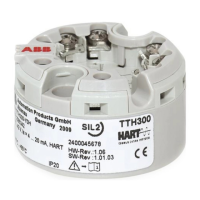TTH300 HEAD-MOUNT TEMPERATURE TRANSMITTER | OI/TTH300-EN REV. E 9
Installation in a potentially explosive atmosphere
Transmitters can be installed in all kinds of industrial sectors.
Potentially explosive systems are divided into zones,
meaning that a wide range of different instruments are also
required. For this, pay attention to the country-specific
guidelines and certificates!
Note
Ex relevant specifications must be taken from the EC-type
examination certificates and other relevant certificates that
apply in each case.
With transmitters for PROFIBUS PA and FOUNDATION
Fieldbus H1 applications, FISCO interconnection methods can be
used.
ATEX – Zone 0
Designation: II 1 G Ex ia IIC T6 Ga
Ex area Zone 0 Safe area
A Sensor
B Transmitter in housing with IP-rating
IP 20
C Supply isolator [Ex ia]
D Interface for LCD indicator
Figure 2: Hookup in ATEX – Zone 0
When using the transmitter in Zone 0, it must be installed in a
suitable housing with IP rating IP 20.
The input for the supply isolator must be designed with ‘Ex ia’
type of protection.
When using the transmitter in Zone 0, make sure that
impermissible electrostatic charging of the transmitter is
avoided (observe the warnings on the device).
As the user, it is your responsibility to ensure that the sensor
instrumentation meets the requirements of applicable explosion
protection standards.
Note
When operating the transmitter in Zone 0 (EPL ‘Ga’), the
compatibility of the device materials with the surrounding
atmosphere must be ensured.
Encapsulation material used for the transmitter:
Polyurethane (PUR), WEVO PU-417
ATEX – Zone 1 (0)
Marking: II 2 (1) G Ex [ia IIC Ga] ib IIC T6 Gb
Zone 0 or 1
Ex area Zone 1 Safe area
A Sensor
B Transmitter in housing with IP
rating IP 20
C Supply isolator [Ex ib]
D Interface for LCD indicator
Figure 3: Hookup in ATEX - Zone 1 (0)
When using the transmitter in Zone 1, it must be installed in a
suitable housing with IP -rating IP 20.
The input for the supply isolator must be designed with ‘Ex ib’
type of protection.
As the user, it is your responsibility to ensure that the sensor
instrumentation meets the requirements of applicable explosion
protection standards. The sensor can be installed in Zone 1 or
Zone 0.
When using the transmitter in Zone 1, you must ensure that
impermissible electrostatic charging of the temperature
transmitter is prevented (observe the warnings on the device).

